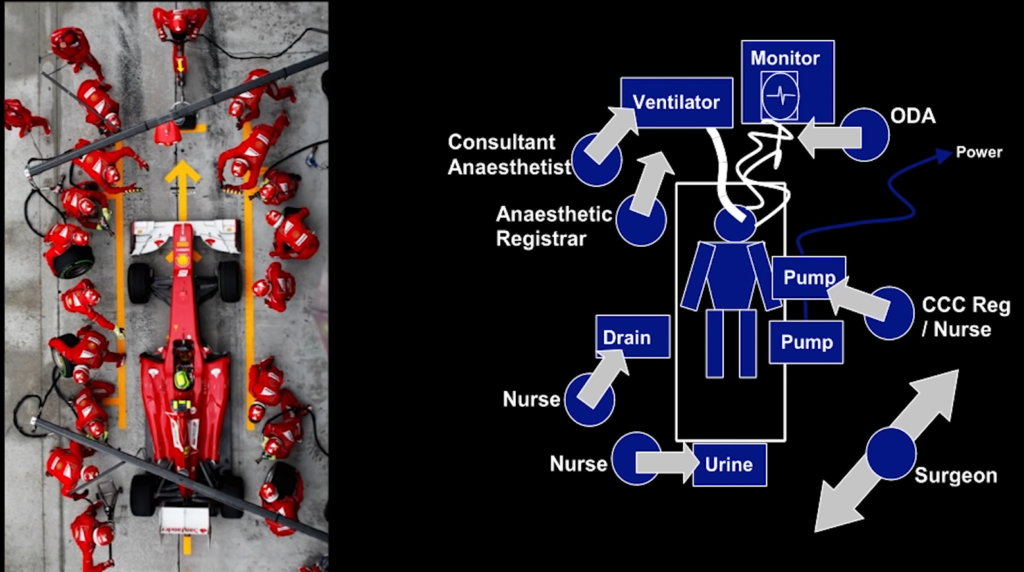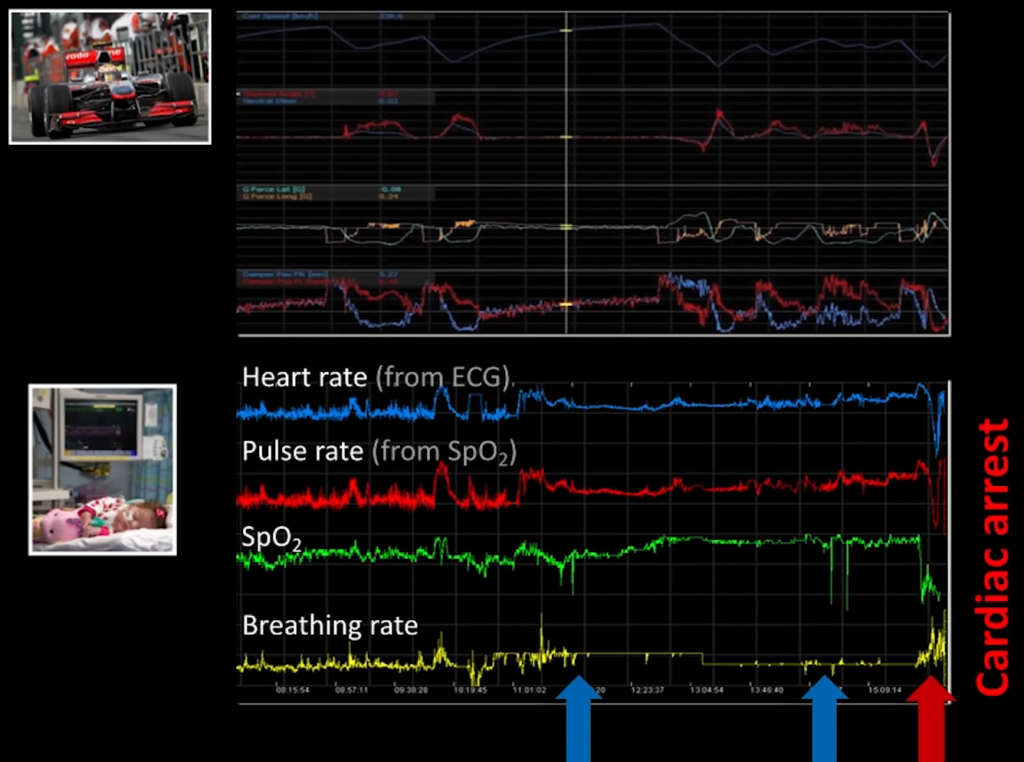Having had the opportunity to watch Professor Elliott’s fantastic Gresham College lecture (https://www.gresham.ac.uk/watch-now/formula-1-and-its-contributions-healthcare), I was intrigued to find the impact of this fast-paced, innovative industry on medicine. The article below represents what I learnt from Professor Elliott’s talk.
First off, you (as was I) may be wondering in what way Formula 1 can truly influence healthcare? However, the surprising reality of how Professor Elliott worked with experts within the F1 industry will demonstrate how he made a difference to his Cardiac Unit at The Great Ormand Street Hospital for Children.
Simply put, the risk factor within every stage of an Intensive Care Operation is huge. Every single wire, syringe, and sensor within the operating theatre has been specifically arranged to ensure that the team of upto 25 medical professionals can save the life of a child. However, research has found that the transfer of a child from the operating theatre to intensive care is riddled with challenges. Every child reacts differently to certain stimuli, and the team of doctors and nurses in the operating theatre really understand what conditions the child is most comfortable in. Yet, acts such as transferring all the monitoring equipment and syringe pumps from the theatre to the intensive care unit are extremely difficult, since one tangle of the wire can be catastrophic. The biggest source of error within this process is the communication between the teams of medics from the operating theatre and the ICU unit. The team who has spent a full day in the theatre with the baby has learnt a great deal, yet after a tiring day of work, they deliver certain amounts of information on an “operation note” and “anaesthetic chart” to the next team, but most of the crucial details are left in their brains, needing the ICU team to experiment once again. Understandably, surgeons can be impatient and short-tempered after performing a difficult operation, meaning that they are not the best communicators at this point!
This is where the genius of Formula 1 came into play. F1 is a sport where intense focus, rapid innovation and teamwork is crucial. Try and spot the similarities between a pit stop and a patient handover (hint: both transfer information at critical turning points). Realising these connections, the Cardiac Unit at GOSH collaborated with Ferrari to see how the key performance details in F1 can be applied to Professor Elliott’s team in the hospital.
For example, leadership is key in the pit stops, where a “lollipop man” coordinates the entire pit stop by overseeing each of the wheels, the surroundings of the car, and essentially makes the final decision as to when the car is ready to press on. In Professor Elliott’s team, he realised that at any stage, there was no clear leader who coordinated the operations at that point. Therefore, an intensivist and anaesthetist were put in charge for both stages of the transfer.
Or if we look at discipline in the hospital, there were many ad hoc, free verbal conversations between colleagues, which occurred simultaneously. This led to further confusion and a lack of structure and therefore communication was limited to the essential moments throughout the day. With contribution, in F1 all members are actively involved in spotting errors since it is a team sport, where they all share a common goal. Previously, in hospitals, the lead surgeon was rarely corrected since the junior members of the team were worried of speaking up. Now, Professor Elliott has instilled a culture where junior members are actually encouraged to speak up each day and provide a way to improve – this changes the atmosphere of the whole workplace, and makes it much more sustainable.
Interestingly, if you see a bird’s eye view of a pit stop, and of a patient being transferred, the structure seems very similar:

The key phrase which Professor Elliott referred to multiple times was how repeatedly rehearsed F1 is. An ex-McLaren engineer importantly realised that:
80% of what happens in a hospital is completely predictable. That would free the intellectual capacity of the staff to sort out the vital 20% that is unpredictable
Peter Van Manen
This structure and knowledge that each team member has reduces the chance of errors, and boosts confidence in high-pressure situations. Surprisingly so, GOSH even worked with a professional dance choreographer to improve the positions of each person to reduce the medics getting in the way of each other.
Once many protocols were implemented in the Cardiac Unit, the results were astonishing. Simple acts such as those outlined above, truly made life-changing differences. There was a 4 times reduction in multiple errors, and moved towards much more effective teamwork.

At every handover in the hospital, risk occurs and therefore Professor Elliott’s work with Formula 1 was inspiring for companies and hospitals all around the world.
Formula 1 store, transfer and analyse incredible amounts of data each race. In fact, information from car performance, aerodynamics, engine temperatures, tyre pressures etc. are all recorded using over 125 sensors on each car sending data on 13,000 health parameters about the car. 750 million numbers are transferred in a two-hour race, and all of this information is huge compared to any other industry. For instance, in the US grand prix in Austin, the teams collected a mammoth 243 terabytes of data for analysis, which is more data than in the entire US Library of Congress in Washington! Data sets, models, and graphical simulations are produced by the factories at the instant the race is completed. These similar analytics used in F1 can be applied to medicine, and can be used to analysis monitored values for each child patient, which can prevent cardiac arrests. The two graphs below have different variables but fundamentally represent the same overview of trends and patterns of data. Algorithms are transferable, and that is how F1 simulations can impact hospitals around the world. McLaren worked with Birmingham Children’s Hospital to allow them to store huge amounts of data for longer than 48 hours (as was previously possible). This allowed them to use Principal Component Analysis which uses statistical techniques to plot various components against each other and predict various observations in the future.

Combine this data with machine learning algorithms and Artificial Intelligence, and eventually, we can develop algorithms that can provide their own medical insight for personalised patient cases (and with reduced error rates than humans). The arrow below shows the strategy to develop these powerful algorithms, and over time, as technology improves this becomes more accurate.

Finally, the rapid innovation and product development in F1 can be applied to design better hospital equipment in a matter of a few days. F1 engineers remarkably manufacture 5000 new components every two weeks, and between each race, the car is 5-10% different compared to the previous race. The use of dynamic modelling in 3D datasets of trachea has meant that disease progress can be modelled using a simulation, without sending telescopes down the trachea of a child.
F1 teams welcome rapid failure in their development, something which hospitals are hesitant about and reduce innovation since they are worried about early adoption to technology. In healthcare, it is unfortunate that different doctors are distrustful of change or innovation taken place elsewhere, and prefer to stay original. However, we should work together and innovation as one community which will together fast-forward the mistakes we make today.
F1 is all about engineers fixing issues, and racing against each other (the drivers are just one small part of the huge innovation battle). If we can take this ethos within F1 of efficiency, teamwork, and problem-solving, then the future of medicine is ready to win a championship!
STRAKA Racing have a powerful motto:
Talent wins races, but teamwork and intelligence win championships
STRAKA Racing
With thanks to Professor Elliott’s talk on the Gresham College website:

